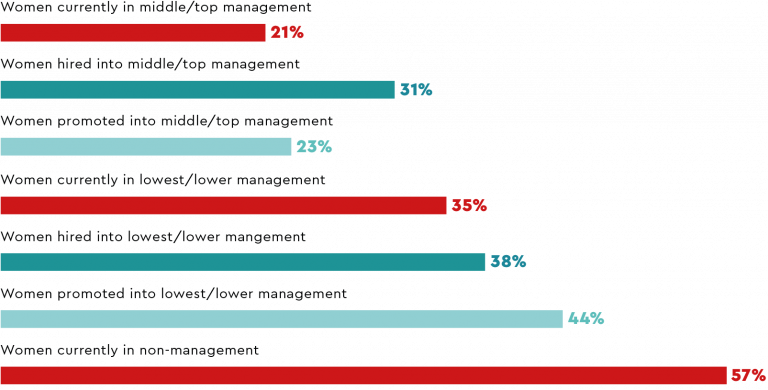In the Insurance industry, there is a stark contrast between non-management and top management. In non-management positions, there are more women than men. However, there is an immediate drop of 15 percentage points at the lowest management, so only 42% of employees at that level are women. This steep decline continues to the top management level, where only 16% of the employees are women. A “burst dam” may be a more accurate description than a leaky pipeline.
Women are better represented at hierarchical levels and in positions that come with less influence and potential for future career advancement: For example, in lowest management (where women have a share of 42%), fewer than 1 in 5 positions comes with personnel responsibility. This indicates that women are primarily in “nominal” management positions (expert or administrative roles).
Not only are the middle and top management levels clearly dominated by men, but these levels are comparatively homogeneous in other diversity dimensions. 80% of male middle and top managers are Swiss, 91% work full-time, the vast majority speaks German and almost 50% are over 50 years old. This means that a wave of baby boomer retirements is expected over the next few years, opening a window of opportunity for diversifying middle and top management.
The Insurance industry is not properly utilizing its talent pipelines for all management levels. Women make up 44% of the lowest and lower management promotions compared to 57% women in non-management and even though the percentage of women in lowest and lower management is 35%, they only make up 23% of promotions in middle and top management.
While the Insurance industry utilizes promotions to increase the share of women in lowest and lower management, new hires barely have a positive effect on the share of women in these levels. In contrast, women are more likely to attain positions in middle and top management via external recruitment than internal development in the Insurance industry.

Men are also better educated than women, which also holds true for the younger generation. This difference in education makes men’s advancement chances considerably higher, as tertiary degrees appear to be the norm for both male and female managers. Among non-managers up to 30, only 21% of women hold tertiary degrees, while 30% of men do. In other words: In this segment of the talent pipeline, young men are still better qualified and have higher chances of making it to the top. In the full sample of industries, no such education difference is discernible. This, too, indicates that in the Insurance industry, young men still seem to be hired for positions with development potential, while women are hired for more administrative roles with less potential for upward mobility. This difference may explain why men are still favored when it comes to promotions.
Why are women not making it to the top? A look at the age distribution among middle and top management promotions helps answer this question. While women’s promotion rates remain consistent across age for lowest and lower management levels, significant age differences exist for middle and top management. The difference in promotion rates emerges during the “family primetime,” between 31 and 50, and is particularly noteworthy between 41 and 50, when almost half of middle and top management promotions are awarded. Between 51 and 60, the share of middle and top management promotions is nearly equal for men and women. It seems there is a tendency to give women another shot at a managerial position after “family primetime.”
For new hires, women and men are hired at equal rates for middle and top management positions until age 40. After that, men get hired at a considerably higher rate.
Further reinforcing the picture of an industry holding on to traditional values and mindsets are the employment percentages of men and women. Only 52% of women in insurance work full-time, while 84% of men do so. These numbers are similar to the full sample of companies participating in GIR. What is striking, however, is that the Insurance industry has a particularly stark difference in men’s and women’s average employment percentages in lower management levels. Moreover, this difference is vast between ages 35 and 45 – i.e., the same age categories where men are disproportionately promoted into middle and top management. For the Insurance industry, there seems to be a clear expectation that managers in middle and top management work full-time – and this mentality may help to explain the leaks in the industry’s diverse talent pipeline.
The Insurance industry should broadly rethink its definition of talent and talent management to consider all employees to be talents. What (diverse) talent do you have, and how can you develop them?